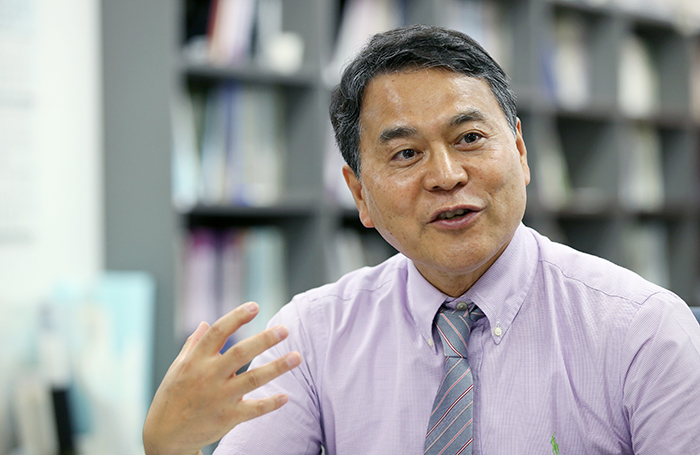
Professor Lee Hee Soo from Hanyang University's Department of Cultural Anthropology talks about exchanges between ancient Korea nations and the Islamic world, in Seoul on Sept. 25. (Kim Sunjoo)
Korea and the Islamic world have had exchanges ever since the Three Kingdoms of Korea period (58 B.C.-A.D. 668) which included Silla (57 B.C.-A.D. 935), Baekje (18 B.C.-A.D. 660) and Goguryeo (37 B.C.-A.D. 668).
Professor Lee Hee Soo at Hanyang University's Department of Cultural Anthropology has been researching exchanges between ancient Korean nations and the Islamic world for 37 years. Korea.net sat down with him to learn more about the history of these exchanges, as seen through ancient records from Korea and from Muslim countries.
Professor Lee Hee Soo at Hanyang University's Department of Cultural Anthropology has been researching exchanges between ancient Korean nations and the Islamic world for 37 years. Korea.net sat down with him to learn more about the history of these exchanges, as seen through ancient records from Korea and from Muslim countries.
By Kim Young Deok and Yoon Sojung
Seoul l Sept. 25, 2017
“King Sejong the Great received an Islamic welcome by listening to a recitation of the Quran.”
Professor Lee Hee Soo of Hanyang University read this phrase written in the “Annals of the Joseon Dynasty” (Joseon Wangjo Silok, 조선왕조실록, 朝鮮王朝實錄), a record of all the many Joseon kings' actions collected between 1413 and 1865. Professor Lee has been studying the history of exchanges between ancient Korea and the Islamic world by deciphering such historic documents.
Professor Lee has been studying the Middle East and Islam for 37 years, since 1978. He is the first Korean to ever received an M.A. in history of the Middle East and Islamic culture from Istanbul University in Turkey.
Professor Lee explained to Korea.net how the Arabic world was depicted in ancient Korean texts, and spoke about the history of exchanges between ancient Korean nations and Islamic regions.
- It's unexpected to hear that there is a record in the "Annals" saying that King Sejong the Great heard a recitation of the Quran.
As with occasions of national protocol to which diplomatic envoys are invited, King Sejong the Great did invite Muslims to attend key events, such as a New Year’s greeting or a coronation ceremony for a crown prince. Records about such events are found in the "Annals of the Joseon Dynasty." One of such except is as follows:
The court rites minister reports that, “Priests and Muslims enter the garden to praise the king.” When it is finished, a royal protocol officer kneels to inform the king that, “They paid homage.” The court ceremony management officer informs the king that the reception is over. Then the king comes down from the throne and the court musicians begin to perform.
--September 1418, the year of King Sejong the Great’s enthronement
This is one piece of evidence that a Muslim leader was invited to attend a royal court ceremony where he said an Islamic prayer to celebrate the king. This actually means that the invited Muslim leader recited the Quran in court. Other similar records about Muslims are also found several times in the "Annals."
- I wonder if Muslims were on the Korean Peninsula before Joseon times (1392-1897).
In early Goryeo times, Arabic traders came to the region. In late Goryeo, people from the Middle East and Turkish Muslims entered the country.
In the book “The History of Buddhism in Joseon,” written by Lee Nung-Hwa, the author quoted a historical record that Muslims built a “worship palace” in Gaegyeong, the Goryeo capital, today’s Gaeseong. Considering the fact that there would be no word like “mosque” in Goryeo times, the Goryeo people seemed to confuse a Buddhist temple with a mosque by expressing the place as being a “palace to pay worship.”
Backed by such historic sources, after the unification of Korea, I have a dream to go to Gaeseong and to unearth this archeological site.
-Looking back at the records about Muslims who settled on the Korean Peninsula, I wonder if they had any effect on ancient Korean society.
From late Goryeo to early Joseon, before King Sejong the Great, political turmoil continued across the Korean Peninsula due to Mongolian invasions, wars to establish Joseon and the Strife of the Princes, the fight between the sons of Joseon-founder Yi Seong-gye concerning the right to succession.
During the reign of King Sejong the Great (r. 1418-1450), many scientific inventions were made, such as the honcheonui optical telescope (혼천의, 渾天儀) and the angbuilgu hemispherical sundial (앙부일구, 仰釜日晷). I believe such phenomena were backed by science from the Islamic world, as these were rooted in the late Goryeo and early Joseon period.
- What future plans do you have to unveil the history of exchanges between ancient Korean nations and the Islamic world?
Traces of the Islamic world are found in many historical Korean documents to some extent.
However, hundreds of old Arabic documents that deal with Silla and Goryeo still remain unopened. Research has been ongoing to unearth and decipher them.
I believe that my goal is to find a treasure that is hidden in the history of exchanges between ancient Korea and the Islamic world.
kyd1991@korea.kr
Most popular
- 2 Egyptian sisters reflect on 10 years as Honorary Reporters
- Actor Bae Doona's first romcom in decade to hit theaters in May
- Korea Welcome Week for foreign tourists set from April 25-May 16
- Korea.net welcomes 2025 K-influencers, Honorary Reporters
- Mini-exhibition brings Korean culture to South London town
